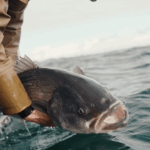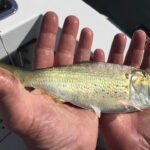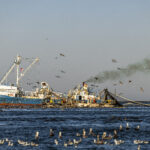
Release Mortality Revisited: New Research from Massachusetts DMF
Feature Photo Credit: Robbie Tartaglia What’s going on? For decades, striped bass management relied on a
The Atlantic States Marine Fisheries Commission (ASMFC) met last Wednesday to take yet another look at Draft Amendment 7 to the Striped Bass Management Plan before releasing a final version for public comment.
Without getting into too much detail, here’s a quick recap of how we got here.
Amendment 7 was born three years ago during the Striped Bass Management Board’s initial consideration of Addendum VI, which was a response to a 2018 stock assessment that showed striped bass were “overfished” (aka depleted) and that “overfishing” (fishing at a rate that such depletion would continue) was occurring.
A few states, Maryland in particular, expressed concerns that the Chesapeake Bay stock (where 60-80% of the coastal stock originates from) had simply become less productive than it had been in prior decades, and that reaching a female spawning stock biomass (SSB) target based on stock productivity in the mid-1990s (when the stock was officially declared rebuilt) perhaps wasn’t possible.
Reading between the lines here, the intent was clear. Lowering the SSB target—in other words, lowering the bar on what constitutes a healthy stock—would open the door for less constraining measures, and simply allow folks to kill more fish than what scientists currently deem sustainable.
The initial ask, however, was that the Board take an entirely new look at how we are managing striped bass under the current Fishery Management Plan, which was last revised through Amendment 6 in 2003. This effort, reflected in the Public Information Document released early last year, included revisiting the plan’s “Goals and Objectives,” the “Biological Reference Points” (what constitutes a sustainable level of fishing and a healthy stock), “Management Triggers” (when the Board is required to take action—e.g., stock overfished, overfishing occurring etc.), “Stock Rebuilding Targets and Schedule” (when should rebuilding start and when should it be completed by), “Regional Management” (manage the stock as a whole or distinct spawning stocks), “Conservation Equivalency” (the process where states can pick their own regulations as long as they are equivalent to the coastwide management measures), “Recreational Release Mortality” (addressing catch and release mortality in the recreational fishery), “Recreational Accountability” (measures to ensure the recreational sector is accountable if they overfishing in any given year, i.e., paybacks) and lastly “Coastal Commercial Allocation” (commercial allocation among states).
The Public Information Document summarizing all of these issues went out to the public in February 2021. Much to the dismay of those states who were clearly hoping to gain cover for liberalizing regulations, the public overwhelmingly told the Board that they weren’t terribly interested in killing more fish, that they wanted the stock managed more conservatively, and that they wanted it rebuilt to the levels we saw all the way up to 2012.
Once the Board met to review public comment, they chose to take out all those issues that had the best chance of allowing for liberalization of regulations amongst states. The big one of course was “Biological Reference Points,” which could have allowed the Board to lower the bar on what a healthy, rebuilt stock looked like. But removing consideration of the “Goals and Objectives” was critical too, because right now those goals are pretty clear on the need to maintain a high level of larger, older fish, not just for coastal availability but to hedge against poor recruitment events.
What the Board ultimately decided to include in Draft Amendment 7 was consideration of “Management Triggers,” “Measures to Address Recreational Release Mortality,” “Stock Rebuilding Targets and Schedule,” and “Conservation Equivalency.” Because a great number of public comments supported protecting strong year classes, another subject, not initially included in the Public Information Document, was added: “Measures to Protect the 2015, 2017, and 2018 Year Classes.”
At the October board meeting an iteration of Draft Amendment 7 was discussed in detail. The intent was to put the document out for public comment after that meeting, but a couple of motions, specifically a motion to initiate a rebuilding plan, needed to go back to the technical committee so that a suite of options could be developed.
And that gets us to where we are now.
Here’s a breakdown:
Management Triggers
The Board started with management triggers.
There are five such triggers under Amendment 6 that require the Board to act when they are tripped.
All of these triggers are common-sense precautionary requirements for management action, the intent of which is to require action before things get bad. And generally they work, assuming the Board takes them seriously.
So why are they being revisited? Well, a “working group” made up of several members of the Striped Bass Board felt that such triggers result in a “lack of stability” in management. In other words, management action and resulting size and bag limit changes could occur too frequently.
We’re not sure where the hell that notion came from given that there have been only two management changes in the last 17 years: One in 2015 when overfishing was occurring and one in 2019 when the stock had become overfished. That certainly doesn’t seem excessive to us.
While a motion to remove this section was made in October—with the exception of the last management trigger (the recruitment trigger which could stand to be improved)—it failed.
So here we are. Trigger 1 is pretty simple. If there is a determination that overfishing occurs in one year, the board must implement measures the following year that would bringing fishing mortality back to target.
Sub-option A2 in Draft Amendment 7 would give board two years to return fishing mortality to the target level.
B2 and B3 allow for delay also. Rather than simply requiring action after an overfishing determination, B2 would require a two year average of overfishing and B3 would require a 3-year average. The kicker with B2 and B3 is that the average cannot include data under different management actions. Given the frequency of assessments (every two years) and the management action that results, there would pretty much never be a scenario where that would occur under B3. And theoretically, overfishing could continue but no management would be required.
When this problem was brought up at the meeting, staff was quick to point out that the Board could act to address overfishing without such a trigger being tripped. But the truth is that the Striped Bass Board hasn’t ever acted without a trigger being tripped since the triggers were put in place back in 2004.
Fortunately, after a brief discussion, there was a motion to remove option B3, and it passed by a wide margin.
Trigger 2 requires the Board to implement measures to rebuild the stock to a spawning stock biomass target within 10 years if the there is a determination that the stock is overfished.
There are currently no options that seek to change that; however, there’s an option later in the document that would require the Board to initiate a rebuilding plan within two years. And that makes sense give there currently aren’t any requirements on when a rebuilding plan must be initiated.
The third and fourth triggers are a little more nuanced, but still common-sense requirements that seek to prevent overfishing or an overfished situation before it happens:
Trigger 3 is tripped is if the fishing mortality “target” is exceeded in two consecutive years. To be clear, “targets” are what management strives to hit, “thresholds” are when determinations such as “overfishing” and “overfished” are made. So, if this fishing mortality target is exceeded for two years and spawning stock biomass dips below target in either of those two years, managers must act to reduce fishing mortality to the target within one year.
Sub-option C2 would allow the target to be exceeded for 3 years before management action would be required, adding more delay. And believe it or not, sub-option C3 would just get rid of a management trigger related to the fishing mortality target, period.
Both of those options will remain in the draft Amendment, and we’d support neither given that C2 promotes more delay and C3 throws out the trigger related to the fishing mortality target altogether, which would mean we’d be managing to the threshold, which is very risky. To simplify that, instead of trying to avoid overfishing with a target, if this option were approved we wouldn’t be taking action until overfishing was occurring.
Trigger 4 requires the Board to rebuild the stock within 10 years if the spawning stock biomass falls below the “target” (not the threshold, but the precautionary target) for two consecutive year and fishing mortality exceeds the target (again, not the threshold) in either of those two years.
Sub-option C2 would require the spawning stock biomass to fall below target for 3 consecutive years before the trigger would be tripped. And sub-option C3 would require no management trigger related to the spawning stock biomass target at all.
Again, while both remain in the document, we wouldn’t support either, as the first allows more delay, while the second would essentially require the Board to wait till the stock become “overfished” before management action is required.
There is, however, one acceptable option in this part of the document. Sub-option B2 would get rid of any trigger related to the female spawning stock biomass threshold. What that means is that instead of requiring action when the stock is overfished, it would require action when the stock is simply below target. From a precautionary standpoint that would seem to make sense. I’m still not sure one could argue that having triggers that include both target and threshold requirements (i.e. status quo) wouldn’t be better than simply a target requirement. But we’ll have to see how this plays out.
Lastly, Trigger 5 in its current formrequires Board action if the combined juvenile abundance index (JAI; young-of-year surveys from all the producer areas, primarily the Chesapeake Bay, Hudson River, and Delaware River) falls below 75% of all other values in the dataset for three consecutive years.
While that sounds good on paper, that trigger has rarely tripped, largely because it includes juvenile abundance data during the super low years in the 1980s when striped bass essentially crashed. So options to revise the recruitment trigger would create a more realistic standard for precautionary management action when recruitment was/is trending down.
There are a lot of options under the “Recruitment Trigger” heading and they get really complicated. We’re not going to go over all of them here, but none of them were taken out, and all of them would seem more conservative than the status quo.
It’s certainly worth pointing out the Tier 4 Deferred Management Action Options. Because, well, they all suck. Each one creates outs for the Board to delay any management action until a new assessment. While there was little discussion on this at the meeting, and all of these options stayed in (some are certainly worse than others), it’s likely we’ll oppose all of these and opt for the status quo requirements.
Measures to Protect the 2015, 2017, and 2018 Year Classes: Recreational Size and Bag Limits
As mentioned, public comment on the scoping document included a lot of comments from stakeholders about the need to protect strong year classes in the stock. Thus, a few meetings back, the Board asked staff to add options that would achieve this. In the draft document discussed at this meeting, a number of alternative size and bag limits were included with analysis on what the projected effect on stock rebuilding would be.
Well, none of them really improved on the current coastal slot limit (28 to 35”) implemented under Addendum VI. To greatly simply why – something like a 35” size limit would protect fish from the relatively strong 2015 year class for a few years – but, well, once they reach 35 or 36”, then of course they aren’t protected. Furthermore, any size limit option just shifts fishing mortality to other year classes. And thus there’s no real benefit in the long run.
Of course, all of this makes sense. But the if intent here is to protect those good year classes (particularly the 2015s) until they could contribute significantly to the spawning stock biomass before they are harvested, it certainly seems like something like a 35” limit would achieve that. Yes, you’re just redirecting fishing mortality onto other year classes, but it’s the 2015s that are abundant and that we’d hope would make a significant contribution to the spawning stock biomass, and thus help with rebuilding.
Regardless, the Plan Development Team recommended taking all of these options out of the draft document prior to approving it for public comment. Not simply because they wouldn’t really help toward an eventual stock rebuild, but because implementing new size and bag limit measures right before a stock assessment update (in October of this year), where it’s entirely possible newer measures would need to be implemented, was problematic.
And so, the Board voted to have this entire section removed.
4.2.2 Measures to Address Recreational Release Mortality
Nothing really was taken out here. Without getting into too much detail this section contains several options pertaining to effort controls (aka seasonal closures), a small option on prohibiting “lethal” gear (i.e., gaffs) to remove stripers from the water, and outreach/education requirements/recommendations on proper release techniques.
Yes, some of the seasonal harvest closures make sense. Particularly a spawning area closure, even though staff can’t tell us what “spawning areas” even mean (i.e., for spawning rivers/estuaries how far downstream they might extend)—there are no maps included in the document. But still, it does make sense to let fish spawn before you kill them.
What’s somewhat irritating though are the “no-target” closure options. Not only would such options close the fishery to harvest, but you technically can’t fish for striped bass even if you have no intention of keeping one. Such closures are problematic for several reasons, but the big one is enforceability. As long as there are bluefish, or fluke, or scup, or black sea bass, etc., most anglers will simply claim to be targeting those species. But who this really screws over is the light-tackle guides who have always largely practiced catch and release. If these no-target closures were to happen, such guides could no longer legally book those sorts of trips during closures. And for what? The Plan Development Team has been clear from the beginning that they can’t even quantify with any precision the impact of such closures. So really, we have no idea what the benefit would be, or if there would be any. None of those no-targeting options were taken out at this meeting. But I suspect the public will come out strongly against them during the public comment period.
4.4 REBUILDING PLAN
As mentioned, this section was added to the document after the last meeting. Nothing was taken out at this meeting but it’s worth pointing out a few things here.
The Plan Development Team notes in the document that there have been several years of poor spawning/recruitment that may indicate the stock is entering a “low recruitment regime” and landings that were considered sustainable during average or above-average recruitment regimes may not be sustainable should low recruitment persist.
So fishing mortality required to rebuild could be calculated by using data from 1990 to the terminal year of the stock assessment (the standard recruitment method used in the striped bass stock assessment), or it could be calculated using data from the below-average recruitment period of 2007-2020 (i.e., low recruitment regime). If we were to go that route, because we assume that recruitment would be lower, the fishing mortality rate to rebuild would need to be lower.
Clearly, given the trends in recruitment, the low recruitment regime seems to be the right one here.
Moving on, perhaps one of the most noteworthy parts of the meeting was a motion by Dr. Mike Armstrong from Massachusetts to create an option that would allow the Board to quickly respond to the October 2022 stock assessment update. In other words, if we get bad news from the October stock assessment, and under the current measures the stock could not rebuild by 2029 (as required by the Management Plan), the Board could act to make reductions without going through the addendum process—which would take at least a year to complete, and thus we likely wouldn’t see any new measures until 2024 at the earliest. Should this option be approved, it would allow the Board to respond quickly and create new measures for 2023.
While it’s a little concerning that this option would seem to bypass the public comment process, I have little doubt—given the concern about striped bass abundance, and the ample public comment up to now on the need to act quickly—that this idea will have wide public support.
Management Program Equivalency (aka Conservation Equivalency)
Lastly, the draft document contains a number of options that would rein in abuses of the “Conservation Equivalency” (CE) program. If you’ve made it this far, I suspect you already know what that term means, but just to be clear, CE allows states to develop measures that presumably have the same conservation value as the coast-wide measures. Where this has failed greatly is in the many instances where states had measures approved that would seem to work on paper, but in real world application, they didn’t come close to achieving the required reduction.
While an option to throw out CE all together was taken out last October, some really good options remain.
There are options that would restrict the use of CE if the stock is overfished, or simply below the spawning stock biomass target, or if overfishing is occurring, or if the fishing mortality rate is over the target. There are also options that require a certain level of precision in the recreational catch data before states could use CE. This is a good because states have certainly used extremely imprecise data to justify CE regulations. And lastly, there are precautionary buffers—the intent of which is to account for the uncertainly in CE regulations—that would be required to be used when developing CE measures.
Fortunately, all of these options managed to make it through this meeting unscathed.
One thing that did stay in, which we certainly would have liked to see come out, was option E1, which appears to allow states to make a percent reduction in their states equal to the coastal reduction, instead of the reduction their states would have taken under the coastwide measures.
For instance, for a state such as New Jersey, which accounts for A LOT of striped bass fishing mortality and thus would have taken a 40% reduction under the coastwide 28” to 35” slot limit, under this option they could take the coastal average reduction of 18%. The result of something like that is the entire plan would be more likely to fail than succeed, because all the states aren’t meeting their share of the reduction. It’s easy to see how something like this would work in real life because, well, it happened two years ago when we were finalizing Addendum VI. The end result was a coastal plan that only had a 42% chance of achieving the 18% reduction it sought.How we allowed that to happen escapes me. But it’s not wrong to assume that the Board let New Jersey’s motion slip by because it was late in the day and everyone was tired.
This egregious option would seem to institutionalize that practice. I really hope the public speaks strongly against one, and I suspect they will.
Where we are now
I would note that this meeting was uncharacteristically short—meaning not painful and drawn-out. I suspect that won’t be the case in May when we consider public comment and maybe finalize Amendment 7. The new Board Chair—Marty Gary from the Potomac River Fisheries Commission—ran a pretty tight meeting, notably giving time to the public to comment on motions. Hard to argue he didn’t do a great job. But I suspect May won’t be that easy.
What happens now? The document will be edited by staff and soon they will release an official draft for public comment.
The ASMFC will accept written comment, but there will also be state-run public hearings (the time and date of which will be posted with the document) where stakeholders like us can voice preference for options and oppose others. Such hearings will presumably be virtual.
The Board will revisit the document at their May meeting, consider public comment and select final measures for the Amendment. Then, the Policy Board and Commission will approve the Amendment, and any new measures will be implemented in the 2023 fishing year.
Of course, it’s VERY important to participate in the public comment process. Your comments up to this point unquestionably moved the dial. We’re pretty much in the home stretch at this point. But if the Board makes the wrong decisions on some of this stuff, particularly the management triggers, we could be looking at a very long period of reduced abundance/availability. And no one wants that.
Stay tuned.
Once those public hearings are announced we’ll get out a cheat sheet to help with comments.
Thanks for reading.

Feature Photo Credit: Robbie Tartaglia What’s going on? For decades, striped bass management relied on a

Recent developments in the 2025 Atlantic Menhaden Stock Assessment Update, released by the Atlantic States

What’s going on? The “most important fish in the sea” just exposed one of the

Mario CampoFisheries Ecologist, Southeastern Louisiana UniversityScience and Policy Associate, American Saltwater Guides Association This discussion
We rely on our members and donations to keep fighting for a sustainable tomorrow in marine conservation.
GIVE THE GIFT OF FISHERIES CONSERVATION THIS HOLIDAY SEASON. SHOP ASGA GOODS THAT FUND FISHERIES RESEARCH & ADVOCACY CAMPAIGNS
JOIN ASGA IN CALLING FOR CRITICAL MANAGEMENT ACTION AFTER YEARS OF SPAWN FAILURES & POOR MANAGEMENT.
By using this website, you agree to our use of cookies. We use cookies to provide you with a great experience and to help our website run effectively. To learn more, please review our privacy policy.
5 Responses
We need consistent coastwise regulations. Do not leave it up to individual states. I believe we should do everything we can to protect the large breeders. What I haven’t heard talked about is the increasing natural predation that is going on. I have personally witnessed, in the last two years, sharks on bass schools, bluefin tuna decimating schoolies, dead bass with bellies torn out in close proximity to seals . And last, although I might get push back on this one, we saw a commotion in the distance and upon coming closer saw porpoises feeding on top and several dead or stoned bass floating on top. This was in 60 feet of water 7 miles south west of Montauk light
Outstanding synopsis. Thank you! As an average, recreational angler, I find it very helpful to have this breakdown. I look forward to continuing my own education on the subjects at hand and will encourage others to do the same. We all share the same goal (hopefully) for a robust, healthy, sustainable fishery for decades to come; not just striped bass, but for all species. Tight lines!
Iv been saying for years no stripedbass should be harvest in any rivers along the East coast. Especially the Hudson River where a lot of breeding occurs in April/May. If you want to really help out and get better numbers a catch and release needs to be implemented during the spawn time. If ppl want to keep a bass from 18-24 inches they should have to apply for fish tags just like deer hunting and only allowed so many instead of one a day.